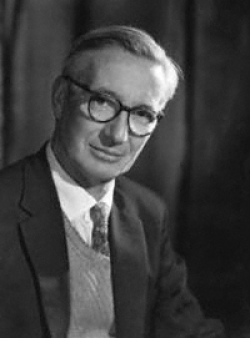Nikolaas Tinbergen

- Born
- 15 April 1907
- Died
- 21 December 1988 (age 81)
Nikolaas Tinbergen, known as Niko, had a passion for the outdoors and a love for observing wildlife from childhood. He exhibited little academic interest growing up but his fascination with animal behaviour began from an early age, when he watched the nest building of sticklebacks in the aquaria that his parents owned.
During 1925 Niko visited Kurische Nehrung, a peninsula between Lithuania and Russia. He observed the mass autumn migration of birds, wild moose and saw the shifting dunes, known as Wanderdȕnen. After this trip he decided to pursue academic studies and completed a degree at Leiden University.
One summer he discovered a colony of bee-hunting wasps known as Beewolves and wrote a thesis on their homing abilities. In 1932 he was given the chance to go to Angmagssalik in Greenland to study the isolated tribe of people living there. Tinbergen and his wife Elisabeth lived there for two years, just before the tribe became westernised. Their lifestyle as hunter gatherers gave them an insight into how ancestral Man had probably lived.
Tinbergen lectured in comparative anatomy at Leiden University and organised an undergraduate teaching course in animal behaviour. He undertook field trips for up to two months which allowed him to continue his studies of beewolves and other insects and birds.
He developed a close friendship with Konrad Lorenz and this was the basis for future collaboration between the two. When the second world war broke out, Lorenz was conscripted as an army doctor and was taken prisoner. Tinbergen spent two years in a German hostage camp, and the two were not reunited until 1949 in Cambridge.
After the war, Tinbergen lectured in America and Britain on animal behaviour. He developed friendships with Ernst Mayr and David Lack which encouraged his interest in evolution and ecology. The topics of these lectures led to the publication of his book, The Study of Instinct, in 1951.
Tinbergen became a British citizen in 1955 and accepted an offer by Sir Alister Hardy to establish a centre of research and teaching in animal behaviour in Oxford. He also helped to found the journal Behaviour. He credited Sir Peter Medawar and Nature Conservancy with offering financial help and support to the research group. This offered unique opportunities for ecologically oriented field work. He was involved in the founding of the Serengeti Research Institute.
Most biologists wear a white coat or Wellington boots, one or the other. Tinbergen does both. In my book, that makes him the most important person in this field this century.
A former student of Tinbergen (Gale Literary Databases, 1999)
Tinbergen’s work with Lorenz and Karl von Frisch, which demonstrated that honeybees communicate by dancing, received the Nobel Prize for Physiology or Medicine in 1973. This was the first ever recognition of work in sociology or ethology, the study of animal behaviour.
When the inter-disciplinary Oxford School of Human Sciences was established, Tinbergen continued his interest in understanding human behaviour using ethological methods. Even after his retirement, he and his wife attempted to explain autistic behaviour in children and published books on the topic.
This profile was written by a Biology: Changing the World volunteer.



